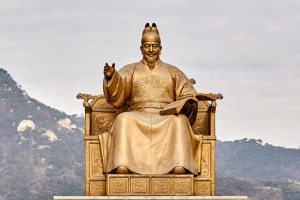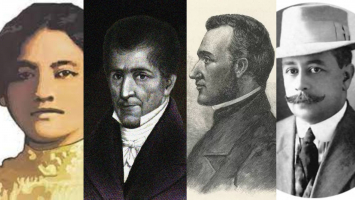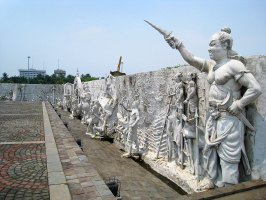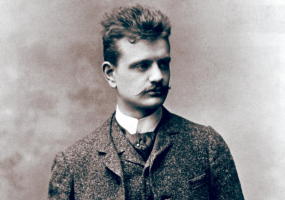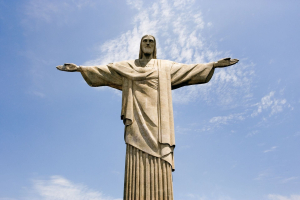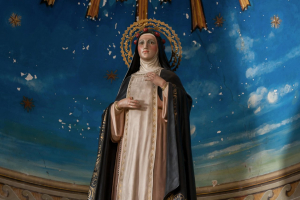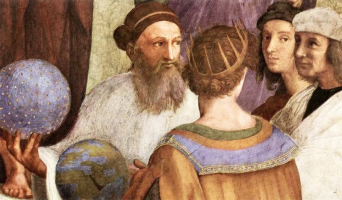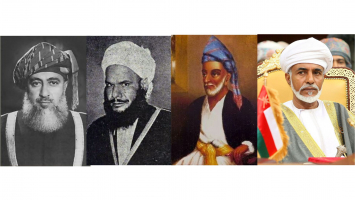Top 8 Mythic Figures in the Three Worlds Cosmology
In the Three Worlds Cosmology, mythical figures embody a unique essence and profound significance. The following eight mythic figures in the Three Worlds ... read more...Cosmology stand out as luminous beacons of wisdom, guiding seekers through the intricate realms of existence and enlightenment.
-
Devas, celestial entities within the Desire Realm, constitute one of Buddhist cosmology's three primary domains of existence. This realm is associated with sensory gratification and various forms of suffering. Within the Desire Realm, Devas are often portrayed as inhabiting distinct planes or levels, each marked by differing degrees of pleasure, power, and longevity.
These luminous beings are described as possessing radiant beauty, basking in heightened levels of pleasure and luxury compared to humans. Their exceptional attributes include supernatural abilities like transformation, clairvoyance, and telepathy.
Buddhist teachings acknowledge the potential for interaction between Devas and humans. Certain narratives within Buddhist texts recount instances of Devas seeking guidance from or engaging with enlightened figures such as Buddhas and Bodhisattvas.
Devas frequently appear as reminders of the transient and cyclical nature of existence. Their existence underscores the imperative of pursuing spiritual advancement and liberation from the cycle of samsara.
Devas are celestial beings dwelling in the Desire Realm, encountering a more refined and pleasurable reality than humans. Their presence within Buddhist cosmology highlights the inherent diversity and reinforces the notion of impermanence permeating all forms of life.
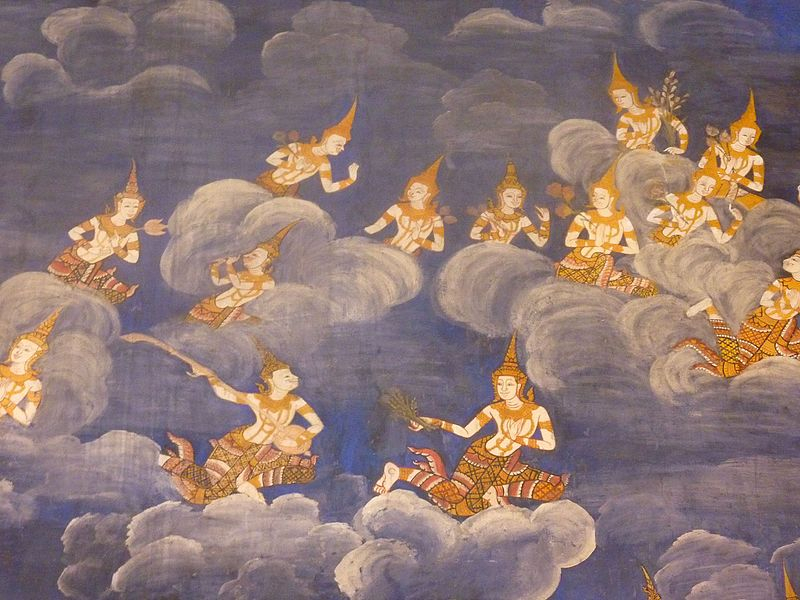
Photo on Wikimedia Commons (https://commons.wikimedia.org/wiki/File:018_Devas_in_Heaven_%289174314518%29_%282%29.jpg) 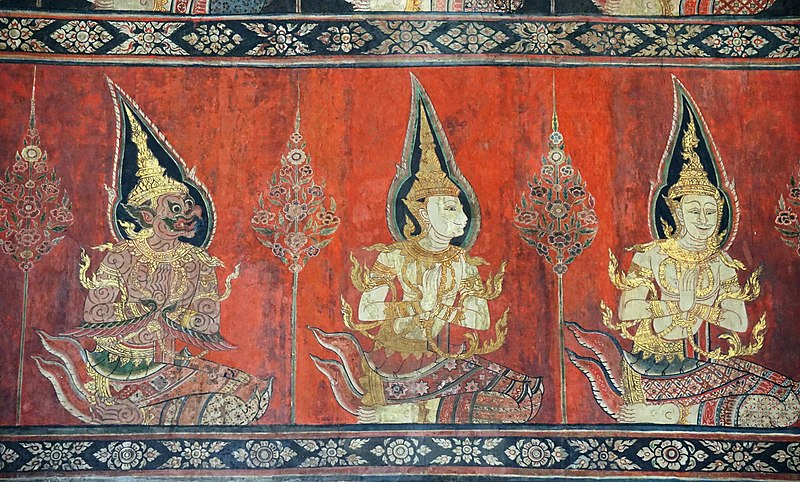
Photo on Wikimedia Commons (https://commons.wikimedia.org/wiki/File:013_Yakkha_and_Devas_%2835252943415%29.jpg) -
Asuras emerge as mythic figures in the Three Worlds Cosmology, particularly in specific interpretations of Hinduism and Buddhism. Often depicted as potent and occasionally antagonistic beings, they inhabit a distinct realm within this cosmological structure.
These celestial beings reside adjacent to the domain of the Devas and other elevated entities. Within this cosmology, they constitute one of the primary triads of beings, coexisting with Devas and humans. Asuras frequently conflict with Devas, their pursuits revolving around the quest for power and dominance.
Fierceness and combativeness characterize the portrayal of Asuras. A complex blend of positive and negative traits defines their nature, encompassing ambition, a thirst for power, and a covetous desire for wealth. Often pitted against the Devas, they function as rivals or adversaries, their confrontations revolving around acquiring precious resources, including the celestial elixir of immortality, known as "amrita."
As cautionary symbols, Asuras vividly illustrate the hazards inherent in excessive ambition, pride, and the allure of power and material riches. Their narratives underscore the fleeting nature of worldly accomplishments. Like all residents within the Three Worlds Cosmology, Asuras remain enmeshed in the birth, demise, and rebirth cycle, their fates intricately interwoven with the karma they accumulate through past actions.
Asuras personify an array of attributes within the Three Worlds Cosmology, encompassing ambition, strife, and the yearning for dominance. Through their interactions with Devas and participation in cosmic clashes, they serve as a conduit for moral lessons and reflections on the intricacies of human nature, desires, and the ripple effects of deeds.
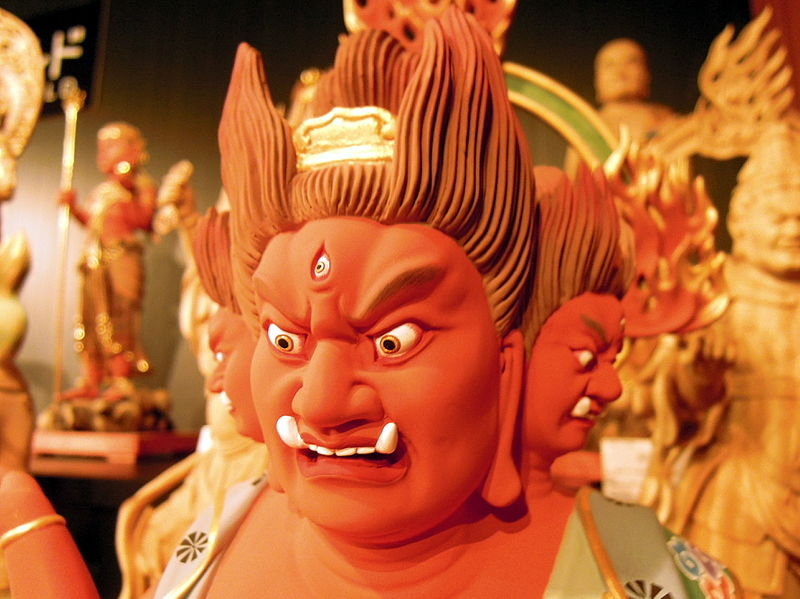
Photo on Wikimedia Commons (https://commons.wikimedia.org/wiki/File:%E9%98%BF%E4%BF%AE%E7%BE%85_Asura_mythical_Indian_creatures,_also_found_in_Japan.jpg) 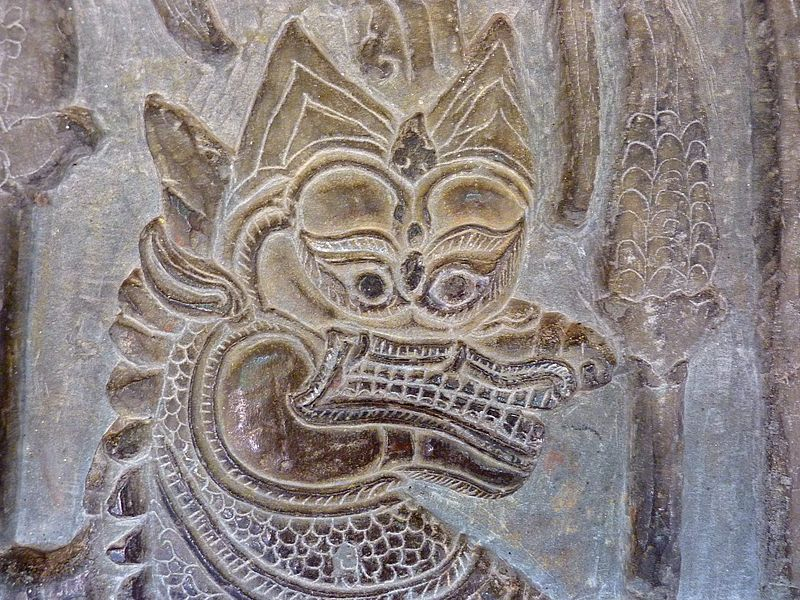
Photo on Wikimedia Commons (https://commons.wikimedia.org/wiki/File:011_Vishnu_and_the_Asuras_Naga_at_Angkor_Wat,_Cambodia.jpg) -
Hungry Ghosts, known as Pretas, are mythic figures in the Three Worlds Cosmology, residing at the juncture between the realms of humans and animals. These entities are marked by insatiable hunger and perpetual discontent.
Pretas are often depicted with gaunt forms and persistently distended stomachs, symbolizing their ceaseless desires. Their unquenchable yearning arises from a fusion of their karma and prior actions, propelling them into this state of being. Consequently, they are perpetually depicted as yearning for nourishment and relief.
In Buddhist and Taoist traditions narratives, Pretas emerge as tormented souls wandering within a realm of suffering. Their cravings go unfulfilled, and the sustenance they seek remains elusive. The domain of Hungry Ghosts is characterized by desolate landscapes, where these entities endure extreme thirst and hunger.
Pretas holds a significant and evocative position within the Three Worlds Cosmology. Their depiction as entities trapped in an unending cycle of insatiable hunger and suffering offers a compelling contemplation on the essence of desire, attachment, and the possible pitfalls inherent in the unbounded quest for earthly delights.
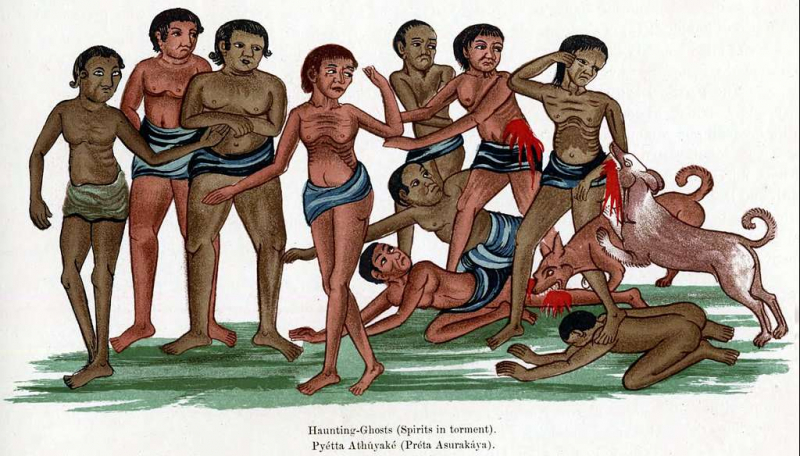
Photo on https://garystockbridge617.getarchive.net/amp/media/pyetta-hungry-ghosts-4ebeec Video by Linfamy -
Hell Beings, referred to as Narakas, are profound mythic entities intricately intertwined with the fabric of the Three Worlds Cosmology. Inhabiting a realm saturated with deep suffering and unending torment, they are a stark antithesis to the elevated realms within the cosmological framework.
In Buddhist narratives, Hell Beings often emerge as subjects of excruciating physical and mental agonies. The character and intensity of their suffering exhibit variation, stemming from the ramifications of their actions and the karma amassed across past lifetimes.
Hell Beings hold a poignant purpose, a vivid reminder of the paramount importance of ethical conduct and the far-reaching repercussions of harmful deeds. Their existence underscores the profound significance of nurturing virtuous behaviors and striving for liberation from the ceaseless cycle of affliction.
Despite epitomizing a state of profound anguish, Hell Beings also present an avenue for introspection and spiritual evolution. According to Buddhist teachings, compassion, benevolence, and moral rectitude offer a route to accumulate positive karma and steer clear of rebirth within such harrowing realms.
Hell Beings assume a substantial and evocative role within the Three Worlds Cosmology. Their depiction as entities trapped within a realm of unrelenting torment is a compelling testament to the karmic consequences of evil actions and the transformative potential inherent in ethical comportment and spiritual endeavor.
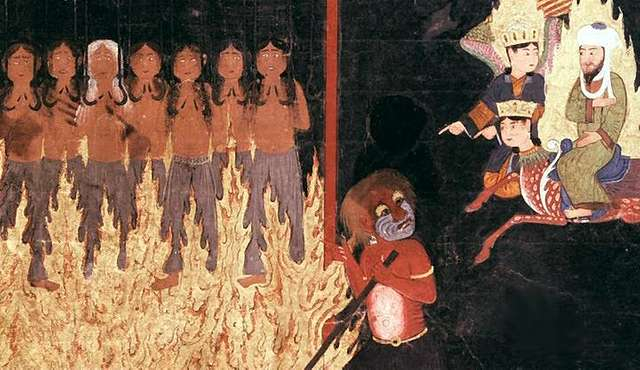
Photo by https://jenikirbyhistory.getarchive.net/amp/media/muhammad-and-hooked-women-in-hell-5908c9 Video by ReligionForBreakfast -
Maras are intricate mythic beings of the Three Worlds Cosmology, notably prevalent in Buddhist traditions. These enigmatic entities personify the influences of delusion, desire, and resistance against spiritual awakening, yielding profound insights into individuals' challenges on the path to enlightenment.
These ethereal figures embody the allure of earthly desires and the veils of illusion that hinder the pursuit of higher truths. Maras are renowned for their endeavors to divert and dissuade individuals from their spiritual awakening journey.
Within Buddhist narratives, Maras are illustrated as employing diverse strategies to undermine one's advancement along the spiritual voyage. They may take on the guise of alluring beings, seeking to entice practitioners away from their quests or manifest as malevolent forces fostering doubt and fear.
In essence, Maras, as mythic figures in the Three Worlds Cosmology, stand as potent symbols embodying the adversities and diversions that challenge individuals in their quest for spiritual illumination. Their portrayal delves deeply into the human psyche, facilitating a profound exploration of the voyage toward transcendence.
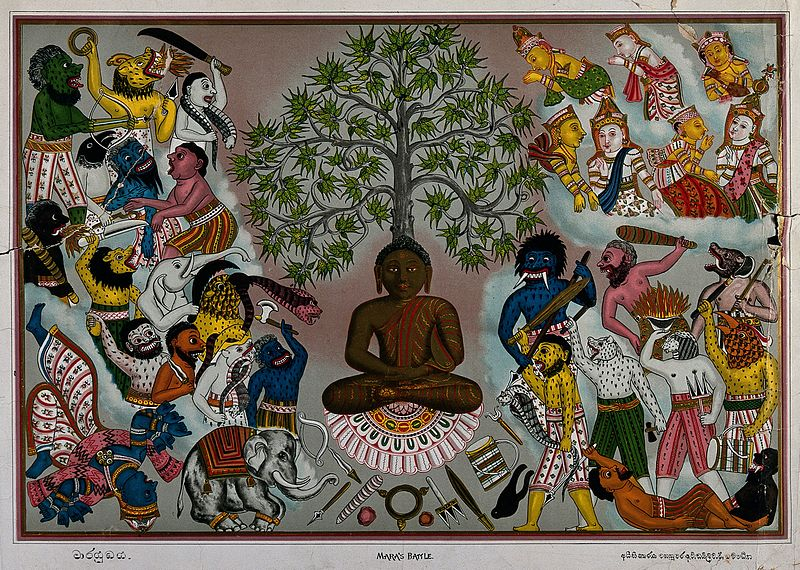
Photo on Wikimedia Commons (https://commons.wikimedia.org/wiki/File:Buddha,_resisting_the_demons_of_Mara,_Wellcome_V0046085.jpg) 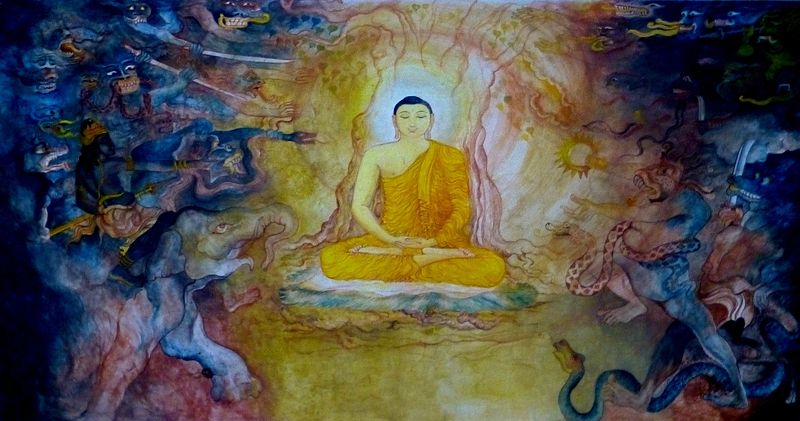
Photo on Wikimedia Commons (https://commons.wikimedia.org/wiki/File:001_Mara_and_his_Horde_attack_the_Bodhisatta_%289241781143%29.jpg) -
The Brahma Devas, positioned among the utmost celestial entities within the Form Realm, are recognized for their profound states of meditation and connection with various tiers of jhana - conditions of meditative absorption that facilitate an experience of elevated consciousness and tranquility.
Buddhist cosmology often depicts these divine beings as inhabitants of distinct levels or planes within the Form Realm. These planes are distinguished by ascending levels of meditative absorption, indicating greater mental purity and subtlety as one ascends.
The presence of the Brahma Devas in the Form Realm underscores the significance of meditation and mental cultivation in Buddhist practice. Serving as exemplars of those who have attained advanced concentration and mental clarity through meditation, the Brahma Devas inspire seekers on the path.
While the Brahma Devas revel in refined modes of existence, they remain trapped in the cycle of samsara- the perpetual cycle of birth, death, and rebirth. According to Buddhist teachings, the ultimate aspiration is to transcend all realms, including the Form Realm, and attain enlightenment - a state leading to liberation from suffering.
The depiction of the Brahma Devas and their role within the Form Realm underscores the importance of meditation as a conduit for attaining heightened states of consciousness and spiritual advancement. While these divine entities are celebrated for their meditative accomplishments, they are also understood as entities yet to attain ultimate liberation, tethered to the cycle of samsara.
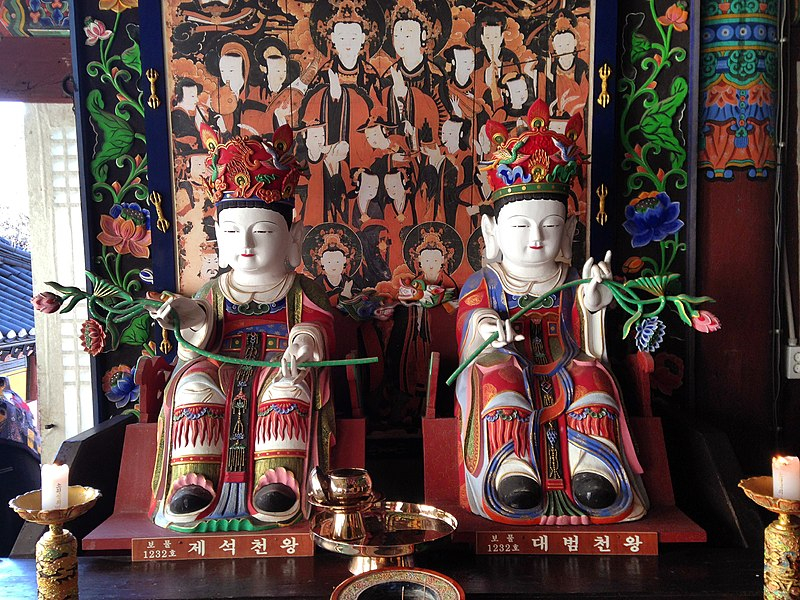
Photo on Wikimedia Commons (https://commons.wikimedia.org/wiki/File:Wooden_Indra_and_Brahma_Deva_03.JPG) Video by SaiBhajanMala -
Manifesting boundless compassion and lofty aspirations, Brahma Sahampati is often depicted as a revered deity who advocates for humanity. Notably, he plays a pivotal role in inspiring Siddhartha Gautama, the historical Buddha, to disseminate his profound insights to the world.
Brahma Sahampati is portrayed as praying to the future Buddha to impart the Dharma (spiritual teachings) for the welfare of all sentient beings. This fervent entreaty acts as a catalyst, prompting Siddhartha Gautama's momentous decision to embark on his enlightening mission. This epochal moment holds transformative significance in the annals of Buddhist spiritual history.
The presence of Brahma Sahampati encapsulates the interconnectedness intrinsic to all beings and their latent potential for enlightenment. His selfless act of urging the Buddha-to-be to share his wisdom becomes a paragon of compassion and altruism, resonating at the very core of Buddhist teachings.
In essence, Brahma Sahampati, as a mythic persona within the Three Worlds Cosmology, is an embodiment of compassion and a wellspring of inspiration. He casts light upon the profound import of selfless endeavors and the intricate interplay of existence. This portrayal is a profound testament to the transformative potency of spiritual insight and the enduring impact of benevolent intentions.
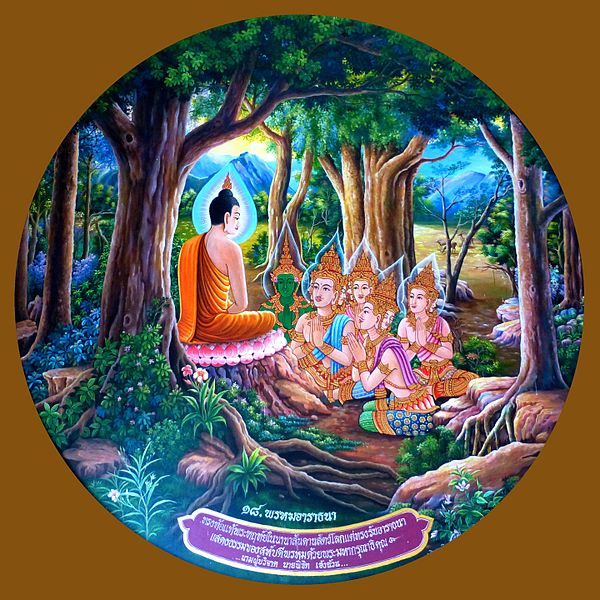
Photo on Wikimedia Commons (https://commons.wikimedia.org/wiki/File:042_Brahma_Sahampati_requests_the_Buddha_to_Teach_despite_his_Reluctance_%289270761017%29.jpg) Video by Himalayan Art Resources, Inc. -
Luminous Beings, celestial and shining mythic entities, embellish the intricate fabric of the Three Worlds Cosmology, a concept intricately interwoven with diverse spiritual traditions. These ethereal figures exude a divine radiance, holding a singular significance within the realms they grace.
These entities are distinguished by their effulgent demeanor, embodying an essence imbued with purity, enlightenment, and divine luminosity. Their radiant nature determines them within the cosmological arrangement, underscoring their profound linkage to elevated states of consciousness.
Luminous Beings frequently assume roles as messengers, guides, or embodiments of spiritual sagacity. Their luminous form is an emblem of their exalted essence, marking their purpose in shepherding and invigorating seekers along their enlightening quests.
Luminous Beings serve as poignant reminders of the inherent luminosity present in all beings, epitomizing the latent potential for spiritual awakening and transcendence. Their presence gently nudges individuals toward connecting with their inner radiance, inspiring a ceaseless pursuit of heightened comprehension and self-realization.
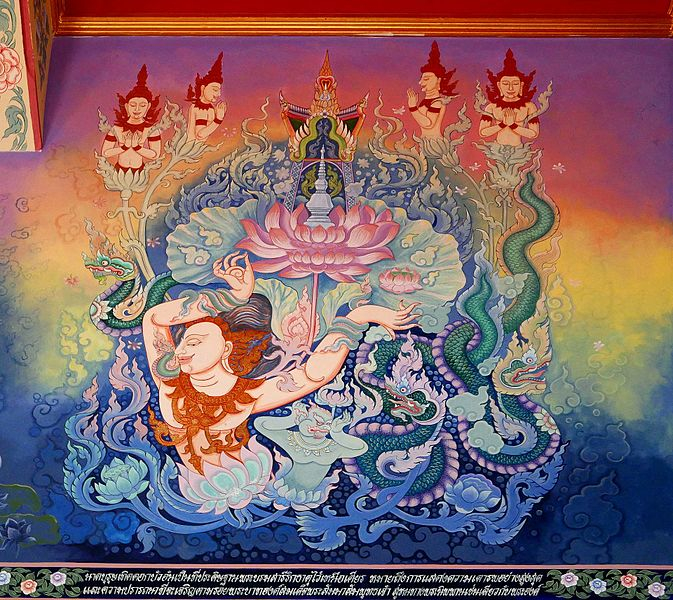
Photo on Wikimedia Commons (https://commons.wikimedia.org/wiki/File:015_Gods_and_Supernatural_Beings_respect_the_Buddha_Relics_%2830663611736%29.jpg) 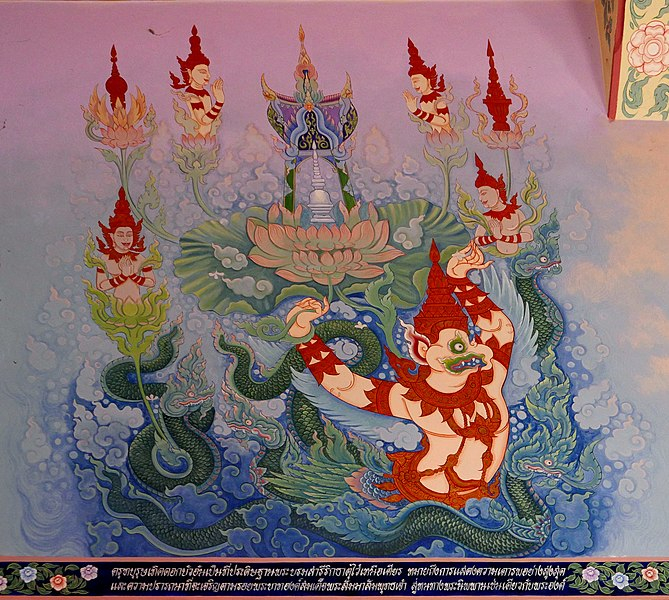
Photo on Wikimedia Commons (https://commons.wikimedia.org/wiki/File:014_Gods_and_Supernatural_Beings_respect_the_Buddha_Relics_%2830068454714%29.jpg)















